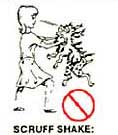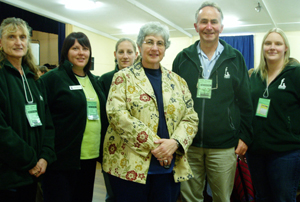Puppy schools are now being run all over the country at dog training schools, dog clubs, animal shelters such as the RSPCA and increasingly at many vet surgeries and pet stores.
When the late David Weston, founder of the Kintala Dog Club in Melbourne, first introduced puppy school into Australia in the mid 1970s he was way ahead of his times. These days the absolute necessity for early and pleasant socialisation to people, things, places and other puppies is fortunately much more widely understood.
Classes that are well run by people with qualifications, knowledge, experience and skills will result in a puppy having many positive experiences.
However, classes that are run by people with little experience who have never owned a dog, let alone trained one well, or people who use "I'm Alpha - do it or else" techniques are woefully inadequate. They are a recipe for untold future behaviour problems. In such instances it is much better for a puppy to not to attend puppy school at all!

Puppies that go to poorly run classes often turn into teenagers who are undersocialised to other puppies, dogs, people and things. They have no manners, are often boisterous and out of control or, even worse and potentially more dangerous, fearful and timid.
As a direct result of their owner's inaction, or their poor choice making, many puppies become dogs who needlessly end up on the end of a chain in the backyard for the rest of their lives or in the 'give-away-to good-home' section of the weekend classifieds.
And some of them go, sadly, on a one way trip to a vet or animal shelter.
Most people realise the inappropriateness of 'dominance' techniques such as alpha rolls and neck scruffing - particularly at puppy school. Although there are still places where such methods are used, it is generally understood that taking a puppy to a well run puppy class that educates owners and uses positive and stress-free strategies gives him a head start to life.

In 2006 a large group of trainers, veterinarians and veterinary behaviourists from around Australia attended the three day “Terry’s Legacy to Oz” continuing education seminar held by Sydney’s Hills District Kennel and Training Club. The key speaker was internationally renowned dog trainer Terry Ryan from USA (below, with CLEAR instructors), author of many great cutting-edge books including “Coaching People to Train Dogs”.

From left: Tina Quinn, Danielle Dickinson, Eliza Borlace, Oliver Beverly, Emma Riches
One of her major objections was that many positive puppy classes in America are being run by people with inadequate qualifications, skills and knowledge. These instructors may be gaining experience but at the same time they are quite likely to be messing up other peoples puppies and doing things that can cause a puppy a great deal of long term harm.
Even if someone has a certificate or a degree in dog behaviour and has read all the books and possibly even written some manuals it does not follow that they are running a good and highly sought after puppy school that a) benefits the puppy's future development and b) increases the owner's knowledge on dog behaviour and dog training.
And in an unregulated industry - where anybody with a little knowledge and experience, few skills and no qualifications can at any time promote themselves as an expert and the world’s top dog trainer (and so often do!) - it is a case of “buyer beware”.
When making enquiries to find a high-quality puppy school prudent owners take the time to find out who is highly recommended. Quality is always remembered long after price is forgotten so it is a good idea to do some research and, if necessary, be prepared to drive further afield than to the nearest vet surgery or pet store.
With a prepared check list of questions it is easier to reach a correct decision. Most of the things to look for are answered by simply watching a class beforehand. If that is not practical (which in a small and overcrowded space in a vet surgery or at a pet store is often the case) the next best thing is talking to several people who have been there about their impressions.
Some suggestions for a check list include but are not limited to the following:
2. Who takes the puppy classes? Do they have an excellent reputation? Do they have good communication and people skills? How widespread is their experience and what are their areas of expertise? Do they listen to the owner’s needs and expectations? Do they find out pertinent details about the puppy’s background and lifestyle prior to the beginning of the first class? Are they welcoming? Do they have a sense of humour? Can they control a class fairly and impartially? Do they keep in touch and follow up throughout the course and after it has finished? (--/20)
3. What are their qualifications? How experienced are they at running well attended puppy classes? Are they interesting and able to keep people’s attention? Are they knowledgeable about all aspects of canine development and many different breeds? Have they raised a puppy or bred a litter of puppies? Do they have a genuine love of and affection for dogs? Score ten if they are a Level lV vet nurse with additional accredited qualifications in behavioural dog training or a similarly qualified breeder or experienced trainer using gentle modern training methods. Score zero if they are an inexperienced vet clinic receptionist, a junior instructor at a dog club or a salesperson at a pet store. They may never have owned a dog and know only a little more than the average first time pet owner. Don’t let them practice on your puppy! (--/20)
4. How many puppies are there per instructor? Are the classes too big - more than eight - or too small - less than four? Does the instructor have an assistant? Are the assistants well-informed, friendly and helpful? Do they wear appropriate clothing and footwear for dog training? Are they in uniform? Do they look professional? (--/20)
5. How and when do puppy to puppy interactions occur? At the beginning of each class or later on and only as a result of calm behaviour? Is the first item on the agenda a general (and often disastrous) free for all socialisation with all puppies playing together? Are barriers or play pens used to separate the puppies? How many puppies are allowed to play with each other at any one time? What happens if one of the puppies is a bully? What allowances are made for shy puppies? Is puppy play frequently interrupted with the puppy coming back to the owner? (--/20)
6. Are the puppies calm and settled and stress free throughout the class? Are the owners alert and interested? Are they all puppies and people having fun and happy to be there? (--/10)
7. Is it possible and is it easy to observe a puppy class in order to observe first hand before deciding to attend it? (If the answer is negative, for any reason - e.g. lack of space, not wanting other people to copy their methods or ideas! score zero. (--/10)
8. Where are the classes held? Church hall, school gymnasium, basket ball court, sports field changing rooms, vets waiting room, vets car park, groomers parlour, pet store warehouse, industrial shed or, if in the tropics, on the beach under a coconut palm? Are the premises, whether indoors or outdoors or a combination of both, clean and safe for puppies? Is there adequate space, of at least three meters, between puppies or are they crammed into a small waiting room? What are the various surfaces that the puppy will be able to experience tiles, concrete, carpet, rubber, sand, grass? Does the class setting provide a welcoming and good environment for learning? Is it free of interruptions? (--/10)
9. When does the next course start? Is it a fixed week class or a flexi week one? Are there too many puppies, people and children in a small room at the same time? What happens if there are not enough puppies for the class to be held? Are people put on a waiting list till there are sufficient numbers? By then it is often too late and the puppy is too old and misses out, so what contingency plans are there to immediately refer them to an associate/colleague or competitor elsewhere? Do they run follow on courses? If not do they provide a list of suitable places using modern training methods where their puppy school graduates can go? (--/10)
10. What happens if the owner or the puppy is ill and can’t come to one or more of the classes? What happens if the instructor is ill and can’t come? What make-up class, wet weather or refund policies are in place? (--/10)
11. How is the course structured? Is there a syllabus available with course content? Are well constructed lesson plans utilized? What training aids or props are used to teach new concepts? Are weekly home training sheets provided with specific suggestions and exercises to do at home? (--/10)
12. When do owners have an opportunity to ask questions? How well are they answered? Can owners easily contact the instructor between classes? Is additional information provided to owners during the week by letter, fax or e-mail? (--/10)
13. Are training aids available? Is there a supply of essential items - for instance blue puppy Kongs, car harnesses, treats and really good puppy books such as “After You Get Your Puppy” or “The Ultimate Puppy Tool Kit”? (--/10)
14. What learning materials are provided or loaned out? A puppy manual? Brochures? Puppy class handouts from a veterinary behaviourist such as those produced by APDT Australia member Dr Debbie Calnon or The First Twelve Months CD produced by Dr Cam Day? Other CDs or DVDs on puppy development? Loan booklets, such as Terry Ryan’s Take the L.E.A.D. or Puppy Primer? (--/10)
15. What do previous owners who have attended puppy classes have to say about their experience at this venue? Are exit survey forms used and available for inspection? Can previous owners be contacted to see how their puppy progressed? Did they enjoy coming? Do they recommend the puppy class to their friends as being good value for money? Would they come again themselves with their next puppy? (--/10)
If the score is less than 125 out of 200, keep looking! A score of 125 - 170 suggests that, if there is no better alternative, it is worthwhile attending but that there is room for improvement in many key areas. A score of 170 + indicates that the puppy school is definitely on the right track but needs to keep on fine tuning its operations via, say, customer exit survey forms.
The main reason to take a puppy to a first-rate puppy school is for education and preventative maintenance for both human and dog. If owners know exactly what to look for, what to expect, how to communicate and what to do it is likely that they will not make fundamental mistakes.
Puppies will understand strange human requirements and grow up as well behaved adults that fit happily into family life. They will want to do what is requested first time, act politely around other people and unfamiliar dogs and can safely be taken anywhere. They will be a pleasure to own, are likely to have happy and interesting lives and grow old graciously.
However, without sufficient early teaching during puppy hood and on-going guidance and education during adolescence, many delightful bundles of eight week old fluff can quickly grow into out of control and even dangerous dogs.
They sometimes pay for their owner’s mistakes - including not attending a good puppy school - with their lives.


